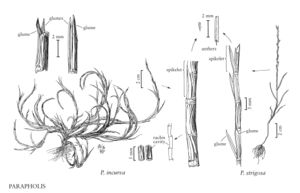Difference between revisions of "Parapholis strigosa"
FNA>Volume Importer |
imported>Volume Importer |
||
| Line 37: | Line 37: | ||
|publication year= | |publication year= | ||
|special status= | |special status= | ||
| − | |source xml=https:// | + | |source xml=https://bibilujan@bitbucket.org/aafc-mbb/fna-data-curation.git/src/bb6b7e3a7de7d3b7888a1ad48c7fd8f5c722d8d6/coarse_grained_fna_xml/V24/V24_973.xml |
|subfamily=Poaceae subfam. Pooideae | |subfamily=Poaceae subfam. Pooideae | ||
|tribe=Poaceae tribe Poeae | |tribe=Poaceae tribe Poeae | ||
Revision as of 22:52, 27 May 2020
Culms 12-45 cm, erect to ascending, branching at the lower nodes. Sheaths of upper leaves usually with the margins all alike, not inflated, not enclosing the lowest spikelets; ligules to 2.3 mm; blades to 2(12) cm long, 1-3 mm wide, flat to inrolled, adaxial surfaces scabrid. Spikes 5-18 cm, straight, not twisted, with 5-25 spikelets. Spikelets 4.5-7 mm, usually slightly longer than the internodes, usually not cleistogamous. Glumes 4-6 mm, lanceolate, acuminate, keels obscure; anthers 1.5-4 mm. 2n = 14, 28.
Discussion
Parapholis strigosa has been found in disturbed areas of Humboldt Bay, California, and has also been reported from Del Norte, Mendicino, and Sonoma counties. It grows on moist soils above normal high tides, usually in well-compacted sandy loams. In general, it is found in less saline soils and at higher elevations than P. incurva.
Selected References
None.
